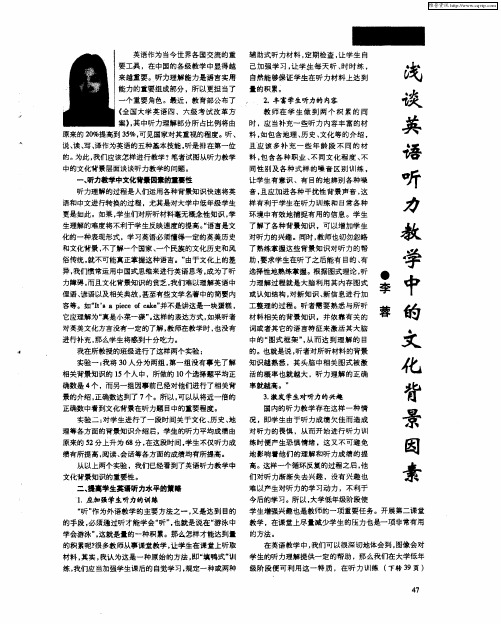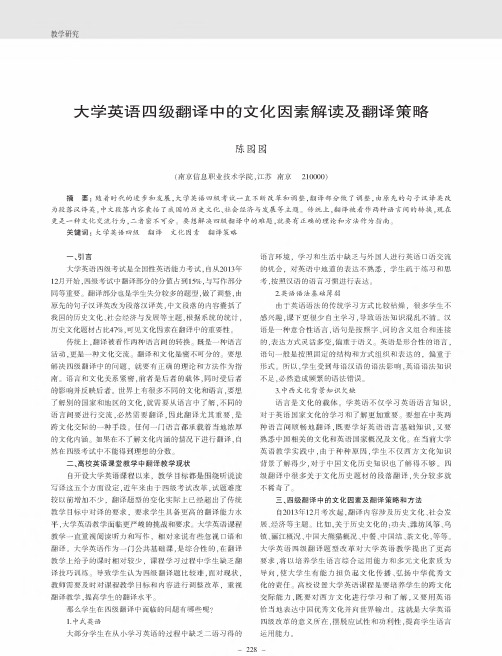英语文化背景因素
英汉词汇文化背景探析

英汉词汇文化背景探析
英汉词汇文化背景探析
英汉词汇在文化背景上有着深厚的联系。
汉语文字在中国历史悠久,英语则是在西方教会传承的。
但是,大多数的英汉词汇都来自于两种语言的深入和细微的融合。
研究英汉词汇的文化背景就是研究这一融合的过程,探析这一融合的来路,了解这一融合的意义和作用。
总体而言,英汉词汇混合、融合之所以发生,是由于语言文化的交流和表述能力的需要等因素使然。
中英两种语言文化作为世界上两大普通语言文化,在历史上有着深厚的联系和交流,其语言结构也是典型性的表现,英语词汇如今改变了汉语结构,也保留了汉语根源,使能够再次注入全新的语料和语言表达内容,这就是构成混合在一起的结果,在一定程度上融合英汉双方的文化、历史价值和价值观念。
此外,英汉语汇的发生还有其他因素,如社会心理学的因素,包括用英文表示的文化强化(cultural reinforcing),比如英文的使用会因为它可以提供文化上一致性的表示,而被更多的使用。
其次,受政治、经济、文化和语言的影响,混合中英语文字也会影响文字的认知和表达,新词语也会源源不断涌现出来。
最后,当进行跨文化交流时,混合英汉文字也会发挥重要的作用,因为它可以节省阅读时间,降低语言学习的障碍。
总之,英汉语汇的文化背景可以从历史文化的视角,有针对性的探测中英两种语言文字之间的起源,特征和各自的文化精髓,从而找到深层次的对话中各自文化交集和融合形式。
而深入理解这一融合,对于当下两种语言文字的跨文化交流,及英语语言表达规范化有着重要的意义。
了解英语国家的文化和传统

了解英语国家的文化和传统2023年,了解英语国家的文化和传统成为越来越多人关注的话题。
在全球化的背景下,了解不同国家与文化的差异和特点,有助于人们更好地融入国际社会。
本文将从历史、宗教信仰、节日、饮食、体育等多个方面,来介绍英语国家的文化和传统。
历史英语国家的历史可以追溯到数百年前,这些国家都体现了不同的历史和文化。
英国是一个古老而丰富的国家,其历史可以追溯到公元前10世纪。
到了中世纪,英国有了大量的城堡和教堂,这些建筑至今仍然呈现着昔日辉煌的壮丽景象。
同时,英国中世纪的语言和文化也影响了今天的英语语言和文化。
美国和加拿大则是英国殖民地,他们的历史可以追溯到16世纪。
这里还有一些新兴的国家,如新西兰、澳大利亚,它们的历史相对较短,但是也非常有特点。
宗教信仰英语国家的宗教信仰也是很有特点的。
英国是一个基督教国家,其国教为英国国教会,教堂是英国重要的文化遗产之一。
美国则是一个宗教多元的国家,基督教和天主教是主要的宗教信仰。
而澳大利亚在宗教信仰方面则更加多元,既有基督教,还有佛教、伊斯兰教等。
除了这些传统宗教,越来越多的人选择了无宗教信仰或新兴宗教。
节日每个国家都有自己的传统节日,英语国家也不例外。
英国最有名的节日之一就是复活节,这是一个基督教节日,是庆祝耶稣基督的复活。
美国最著名的节日是感恩节,这是一个表达感恩、团聚的节日,通常是在每年11月的第四个星期四。
加拿大则有国家庆典节日和圣诞节等传统节日。
此外,在英语国家还有很多独特的节日和活动,例如在英国的农历新年(又称“春节”)和澳大利亚的“澳大利亚日”等。
饮食英语国家的饮食文化也非常丰富多样。
英国的传统美食包括炸鱼和薯条、肉馅派、面包布丁等。
美国的传统美食则包括汉堡、烤肉、披萨等。
加拿大则以枫树糖浆、生蚝和蒸汽肉饼(Poutine)而闻名。
澳大利亚则以烤肉和海鲜为主,其中烤大虾(Prawns)是美食之一。
此外,在英语国家的主要城市中,还有许多各具特色的餐馆和小吃摊,比如伦敦的印度餐厅、美国的汉堡王和肯德基等。
英语语言习得的社会文化背景探讨

英语语言习得的社会文化背景探讨语言是人类交流的重要工具,英语作为全球通用语言之一,其习得过程受到多种因素的影响。
社会文化背景在英语语言习得中扮演着至关重要的角色,它不仅影响着学习者的学习动机、学习方式,还对语言的理解和运用产生深远的影响。
社会文化背景对英语语言习得的影响首先体现在语言环境方面。
一个以英语为主要交流语言的环境能够为学习者提供大量的语言输入和实践机会。
例如,在英语国家生活或学习的人,每天都能接触到真实的英语语言运用场景,如街头的标识、电视节目、与当地人的交流等。
这种沉浸式的语言环境能够帮助学习者更自然地习得语言的语音、语调、词汇和语法。
相比之下,在非英语国家,学习者往往缺乏这样丰富和真实的语言环境,更多地依赖于课堂教学和有限的语言材料,这在一定程度上增加了习得的难度。
文化因素也在很大程度上影响着英语语言的习得。
语言是文化的载体,英语中蕴含着丰富的西方文化内涵。
比如,英语中的许多词汇和表达方式与西方的历史、宗教、价值观等密切相关。
如果学习者不了解这些文化背景知识,就可能会在理解和运用语言时出现偏差。
例如,“Christmas”这个词,对于熟悉西方文化的人来说,它不仅仅是一个节日的名称,还涉及到一系列的庆祝活动、传统习俗和宗教意义。
而对于不了解西方文化的学习者,可能只把它当作一个普通的单词来记忆,无法真正理解其背后的丰富内涵。
教育体系和教学方法也是社会文化背景的重要组成部分。
不同的国家和地区有着不同的教育理念和教学方法,这对英语语言习得的效果产生直接影响。
在一些注重应试教育的地区,英语教学可能更侧重于语法和词汇的讲解,而忽视了语言的实际运用能力和跨文化交际能力的培养。
而在一些强调素质教育的地区,可能会更注重培养学生的听说读写综合能力,通过创设各种情境让学生在实践中学习英语。
家庭背景对英语语言习得也有着不可忽视的作用。
如果一个家庭重视教育,并且有良好的学习氛围,家长能够给予孩子积极的支持和引导,那么孩子在英语学习方面往往会有更好的表现。
浅谈英语听力教学中的文化背景因素

学 会游 泳” 这就 是量 的一 种积 累。那么 怎样 才 能达 到量 。
“ ” 为外 语 教学 的 主 要方 法 之一 , 听 作 又是 达 到 目的 学 生 增强 兴趣 也是 教 师 的一 项 重要 任 务 。开展 第 二课 堂
国内 的 听 力教 学 存 在这 样 一 种 情
浅 谈 英 语 听 力 教 学 中 的 文 化 背 景 因 素
对听力的畏惧 ,从而开始进行听力训 地影响着他们 的理解和听力成绩的提 高 。这样一个循环反复的过程之后 。 他
们 对 听 力渐 渐 失去 兴 趣 ,没 有兴 趣 也 难 以产生 对 听 力 的学 习 动 力 ,不 利 于 今 后 的学 习 。所 以 , 学 低年级 阶 段使 大 教学 ,在 课堂 上尽 量 减少 学 生 的压 力也 是 一项 非常 有 用
时 ,应当补充一些听力内容丰富 的材
料 , 包 含地 理 、 史 、 如 历 文化 等 的 介 绍 ,
说、 、 、 读 写 译作为英语的五种基本技能 , 听是排在第一位 且应 该 多补充一 些年龄 段 不同 的材 的。 为此 , 我们应该怎样进行教学 ? 笔者试图从听力教学 料 。 含 各 种 职 业 、 同 文 化 程 度 、 包 不 不 中的文化背景层面谈谈听力教学的问题。
我在 所教 授 的班级 进 行了 这样 两个 实验 ; 中的 “ 式 框 架 ” 从 而 达 到 理 解 的 目 图 。 的 。也就 是说 , 者对所 听 材料 的背 景 听
力 解 程 是 脑 用 内 图 云 理过就大利其存式
工整理的过程。听者需要熟悉与所听 盏
实验一 : 我将 3 O人分为两组 , 第一组没有事先 了解 知 识越 熟 悉 ,其 头 脑 中 相关 图式 被 激 相关背景知识的 1 5个人中,所做的 1 个选择题平均正 活的概率也就越大 ,听力理解的正确 O 确数是 4个 ,而另一组因事前已经对他们进行了相关背 率就越高。” 景的介绍 , 正确数达到了 7个。所以。 可以从将近一倍的 正确数中看到文化背景在听力题目中的重要程度。 理等各方面的背景知识介绍后 ,学生的听力平均成绩由 绩有所提高 , 阅读、 会话等各方面的成绩均有所提高。 从以上两个实验 。我们已经看到了英语听力教学中 文化背景知识的重要性 。 3 激发学生对听力的兴趣 .
颜色在英语中的文化知识

颜色在英语中的文化知识颜色在英语中的文化知识非常丰富。
以下是一些关于颜色的英语表达及其文化背景:1. Red(红色):红色通常与爱情、激情和能量相关联。
在中国文化中,红色代表喜庆、好运和繁荣。
在西方文化中,红色也与圣诞节和情人节等节日有关。
2. White(白色):白色通常与纯洁、无暇和神圣相关联。
在中国文化中,白色用于丧葬仪式,表示哀悼和尊重。
在西方文化中,白色是婚礼的传统颜色,象征纯洁和幸福。
3. Black(黑色):黑色通常与悲伤、死亡和神秘相关联。
在中国文化中,黑色用于丧葬仪式,表示哀悼和尊重。
在西方文化中,黑色也与葬礼有关,但在某些场合,如晚宴或正式活动,黑色被视为优雅和高贵的颜色。
4. Blue(蓝色):蓝色通常与宁静、和平和忠诚相关联。
在中国文化中,蓝色代表天空和海洋,象征着广阔无垠和无限可能。
在西方文化中,蓝色也与忠诚和信任有关,如“忠诚如蓝色”的说法。
5. Green(绿色):绿色通常与自然、生命和希望相关联。
在中国文化中,绿色代表春天和新生活,象征着生机勃勃和希望。
在西方文化中,绿色也与环保和可持续发展有关。
6. Yellow(黄色):黄色通常与智慧、快乐和阳光相关联。
在中国文化中,黄色代表皇家和贵族,象征着权力和财富。
在西方文化中,黄色也与快乐和活力有关,如“欢乐的黄色”的说法。
7. Brown(棕色):棕色通常与地球、稳定和可靠相关联。
在中国文化中,棕色代表土地和丰收,象征着勤劳和节俭。
在西方文化中,棕色也与自然和舒适有关。
8. Pink(粉色):粉色通常与温柔、浪漫和女性相关联。
在中国文化中,粉色代表柔和和温馨,象征着女性的柔情和美丽。
在西方文化中,粉色也与少女心和甜蜜的爱情有关。
9. Purple(紫色):紫色通常与神秘、奢华和权力相关联。
在中国文化中,紫色代表皇室和贵族,象征着高贵和尊贵。
在西方文化中,紫色也与神秘和创造力有关。
英语语言文化的体现与研究

英语语言文化的体现与研究英语作为一门全球通用的语言,在国际交流、文化传播方面发挥着巨大的作用。
然而,对于非英语国家的人来说,学习英语并不仅仅是学习一种语言,更是了解和融入英语文化的一种方式。
本文将通过对英语语言文化的体现与研究,探索英语语言和文化之间的紧密关系。
一、英语语言中的文化隐喻语言是一种文化符号,表达着人们对世界和人生的认识、理解和感受。
英语语言中的文化隐喻体现了英语文化的独特性和丰富性。
例如,常用的“break a leg”这一表达在英语世界中表示祝福和成功,而在其他文化中可能没有类似的表达。
同样的,如果你在英语世界中听到某人说“I’m as cool as a cucumber”,那么你就能够了解到这个人非常镇定冷静。
除了以上的例子以外,英语语言中还存在着许多关于颜色、动物、习俗、神话等方面的隐喻。
这些隐喻在英语文化中常见,但在其他文化中可能没有或诠释不同。
因此,在学习英语语言的同时,了解英语文化的隐喻也是非常重要的。
二、英语语境和文化背景英语语言与英语文化之间的联系并不局限于文化隐喻。
它们之间的关系还体现在了英语语境和文化背景当中。
在英语交流中,人们经常使用一些特定的词汇、词语、句子结构和语调,这些都是建立在英语文化背景之上的。
比如,当我们听到一句“Just do it”,我们自然会想到耐克公司的广告语,因为这是一个嵌入了英语文化的流行语。
同样的,英语中的一些词汇和短语在具体的英语文化和语境中也可能有不同的含义。
如英语中的“tea time”虽然字面意思是“下午茶时间”,但在英国文化中则有更为宽泛的含义,也是英国人与家人、朋友和同事交流的重要时刻。
因此,要想真正掌握英语语言,我们不仅需要学会语法、词汇和发音,更需要了解英语文化和语境,并学会在不同的情境中运用语言。
三、英语文化的影响语言和文化之间是相互影响的关系。
英语作为一种全球通用的语言,其语言和文化还在不断地影响着其他文化和语言。
个人文化背景介绍英语

个人文化背景介绍英语Personal Introduction of Cultural Background in EnglishIntroductionMy cultural background plays a significant role in shaping my identity and worldview. Growing up in a multicultural environment, I have been exposed to various traditions, customs, and languages. In this article, I will provide an overview of my personal cultural background, highlighting the key aspects that have influenced my life.Family BackgroundI come from a mixed cultural background, with my mother being from China and my father from France. This multicultural upbringing has allowed me to experience the best of both worlds. From a young age, I was exposed to Chinese and French customs, traditions, and languages. This diversity has greatly enriched my understanding of different cultures and broadened my perspectives.LanguageBeing raised in a multicultural family, languages have played a pivotal role in my life. From an early age, I was exposed to Chinese and French languages simultaneously. My mother insisted on speaking Mandarin Chinese at home, while my father used French as our primary language. As a result, I am fully bilingual, fluent in both languages. This linguistic ability has facilitated my communication skills and enabled me to bridge cultural gaps.CuisineFood, with its diverse flavors and ingredients, is an integral part of cultural identity. In my family, the fusion of Chinese and French culinary traditions created a unique gastronomic experience. From devouring steamed dumplings and Peking duck to relishing escargot and croissants, I have developed a deep appreciation for both cuisines. This exposure to diverse flavors has stimulated my interest in exploring new culinary experiences and understanding the cultural significance behind them.Festivals and CelebrationsAs a child, I participated in various traditional festivals and celebrations from both Chinese and French cultures. Chinese New Year, with its vibrant dragon dances and firecrackers, has always been a highlight of the year. Similarly, Bastille Day, the French national holiday, filled with parades, fireworks, and communal celebrations, holds a special place in my heart. These festivities have exposed me to cultural rituals, folklore, and a sense of community, fostering my respect for diverse traditions.Art and LiteratureArt and literature provide profound insights into a culture's values, beliefs, and history. Growing up, I was exposed to both Chinese and French artistic forms. Chinese calligraphy and ink paintings captivated me with their elegance and symbolism, while French literature introduced me to great writers such as Victor Hugo and Albert Camus. Exploring these art forms has not only expanded my aesthetic appreciation but also deepened my understanding of the cultural contexts in which they originated.ConclusionMy personal cultural background, influenced by both Chinese and French traditions, has undoubtedly played a pivotal role in shaping my identity. The exposure to diverse languages, cuisines, festivals, and art forms has provided me with a unique perspective on the world. Embracing my multicultural heritage, I have developed a sense of adaptability, open-mindedness, and appreciation for diversity. Overall, my cultural background is an integral part of who I am, fueling my curiosity and passion for exploring different cultures.。
人文英语全部复习资料

人文英语全部复习资料人文英语全部复习资料人文英语是大学英语四级考试的一部分,主要涉及英语语言的文化背景和社会人文知识。
在备考过程中,掌握一些人文英语的复习资料是非常重要的。
本文将为大家提供一些人文英语的复习资料,希望能够帮助大家更好地备考。
第一部分:文化背景知识1. 英国文化英国是一个历史悠久、文化底蕴深厚的国家。
在复习英国文化时,可以了解一些英国的历史、文学、音乐、艺术等方面的知识。
例如,可以了解莎士比亚的作品、英国皇室的历史、英国音乐家的成就等。
2. 美国文化美国是一个多元文化的国家,其文化包括了美国历史、文学、电影、音乐等方面的内容。
在复习美国文化时,可以了解一些美国的历史事件、美国文学的代表作品、好莱坞电影的发展等。
3. 中华文化中华文化是中国传统文化的总称,包括了中国的历史、文学、哲学、艺术等方面的内容。
在复习中华文化时,可以了解中国的四大发明、中国古代文学的代表作品、中国传统绘画的特点等。
第二部分:社会人文知识1. 社会问题社会问题是人文英语考试中的一个重要部分,涉及到社会的各个方面,如教育、环境、健康等。
在复习社会问题时,可以了解一些当前社会热点问题,如教育公平、环境保护、健康生活方式等。
2. 国际关系国际关系是人文英语考试中的另一个重要部分,涉及到各个国家之间的关系以及国际组织的作用。
在复习国际关系时,可以了解一些国际组织的成立和发展、国际间的合作与冲突等。
3. 科技与文化科技与文化是一个相互影响的领域,科技的发展对文化的演变有着重要的影响。
在复习科技与文化时,可以了解一些科技对文化的影响,如互联网的普及对传统媒体的冲击、科技创新对艺术表达的改变等。
第三部分:学习方法1. 多读多写人文英语考试中,阅读和写作是两个重要的能力。
通过多读一些英语材料,如英文小说、英文报纸等,可以提高阅读理解的能力。
同时,多写一些英语作文,可以提高写作的能力。
2. 多听多说听力和口语是人文英语考试中的另外两个重要部分。
英语电影字幕翻译中的文化因素及翻译策略

英语电影字幕翻译中的文化因素及翻译策略引言:随着全球化的推进,英语电影扮演了世界各地人们娱乐、学习英语以及了解不同文化的重要角色。
电影字幕翻译是将电影中的对话和文字转化为不同语言的过程,而在这个过程中,文化因素扮演了重要的角色。
本文将探讨英语电影字幕翻译中的文化因素,并提出一些翻译策略。
一、文化因素对英语电影字幕翻译的影响1. 背景知识与文化难题:电影中的对话常常包含各种背景知识和文化细节,这使得电影字幕翻译面临着一些困难。
例如,英语电影经常涉及到特定地理位置、历史事件、名人或文化象征等。
如果观众在字幕中没有获得足够的背景信息,就可能无法理解电影场景的真正含义。
2. 文化差异与幽默翻译:不同的文化对幽默有不同的理解。
电影中的幽默经常依赖于语言的双关语或文化特点。
因此,翻译者需要考虑如何在字幕中传达电影中的幽默元素,同时确保观众能够理解和欣赏到电影的幽默。
3. 社会习俗与礼仪:电影中还包含各种社会习俗和礼仪,这也是字幕翻译需要注意的一个方面。
例如,不同国家的问候方式、礼节和社会规范可能有很大的区别。
翻译者需要根据观众的文化背景,采取合适的翻译策略,确保字幕在传达情节的同时,尊重不同文化之间的差异。
二、英语电影字幕翻译的策略1. 保留文化特色:在电影字幕翻译中,保留文化特色是非常重要的。
翻译者可以尽量保持原文中的文化特色,将其传达给观众。
例如,如果电影中出现了某种特定的习俗或文化象征,可以在字幕中添加一些适当的解释或说明,以帮助观众更好地理解。
2. 考虑观众的背景:考虑观众的文化背景也是字幕翻译策略的一部分。
翻译者需要了解观众对于电影中的文化差异和细节的理解程度。
在翻译过程中,可以根据观众的背景知识和文化理解,在字幕中增加一些必要的背景信息,以便他们更好地理解电影的含义。
3. 简化和转换:有些文化细节在字幕中很难直接传达,这时翻译者可以使用简化或转换的策略。
例如,对于一些具有特定文化背景的笑话或幽默元素,可以尝试使用类似的幽默元素,而不是直接翻译,并在字幕中添加一些有关文化的背景信息,以便观众能够理解。
为什么英语成为了全球通用的语言?

为什么英语成为了全球通用的语言?随着全球化和科技的发展,英语已经成为了全球最为通用的语言之一,被认为是跨国交流和沟通的重要工具。
为什么英语能够成为全球通用的语言呢?下面我们来一起探究一下。
一、英语的历史背景英语源于古代日耳曼语族,经过漫长的演化和变迁,形成了今天我们所使用的现代英语。
英语的历史背景与英国的历史密不可分。
自文艺复兴时期开始,英国逐渐成为欧洲的一股强势力量,英国文化和英语也逐渐向世界各地扩散。
随着英国在19世纪初时期的工业革命和海外扩张,英语更加广泛地传播开来。
英语成为了英国殖民地和其他国家的官方语言,也被引进到各个领域,包括科学、技术、贸易、文学、艺术等等。
二、英语的通用性1.商业协议英语成为商业交往和协议的主要语言,这一点难以否认。
在全球范围内,英语已经成为最为普遍通用的语言之一。
跨国公司、金融机构、国际组织、跨国贸易等等活动都需要用到英语来进行商务沟通和协商。
2.科技研究科技研究是各个领域都少不了的一个方面。
将来或许会出现新的跨国组织和协议,使得新兴语言在全球范围内得到更广泛的推广。
但是,目前英语已经广泛地应用在科技研究中,被用作各种学术交流、研究报告和论文的交流语言。
3.文化影响当前,英语作为一种文化和艺术的交流语言也得到广泛的应用。
在全球范围内,英语已经成为流行音乐、电影、电视剧等文化文艺产品的主要语言。
这些英语文艺作品的大量播出和传播,也使英语成为全球各地人们了解和学习的首选语言。
三、结论静态因素的影响使英语成为世界上最为普遍通用的语言之一,并且稳定在了很长时间里。
随着全球化和科技的发展,英语的通用性有可能会被新兴语言所替代。
但是从目前的现实情况来看,英语的通用性依然非常重要。
学习英语,掌握英语交流的技巧和能力,对我们的工作、学习、文化交流等方面都是非常有益的。
谈英语语言中的种族歧视及其文化背景

从心理语言学角度谈英语中的种族歧视现象一、语言中的种族歧视种族歧视(racial discrimination),是指根据种族将人们分割成不同的社会阶层从而加以区别对待的行为,即种族与种族之间的歧视。
统治阶级根据种族和民族的特征,划分人们的社会地位和法律地位,敌视、迫害和不平等地对待其他种族的行为,也是阶级剥削制度的产物。
种族歧视始于古罗马帝国时代,其现代形式是从资本主义原始积累时期开始的,主要包括剥夺选举权、受教育权和其他权利,压低工资,任意逮捕、拷打甚至杀害,强行限制在“保留地”内居住等。
迄今为止,还有许多资本主义国家普遍存在种族歧视现象。
调查结果被研究者视为种族偏见已经植根于美国不公平历史的强力证据。
但是现在黑人所受到的社会福利要远好于其他族裔,由于美国政府政策偏向黑人,在许多工作岗位都必须应聘黑人,同一学历黑人会比白人优先招聘。
黑人歧视亚裔的现也普遍存在,比如在1992洛杉矶事件中,黑人针对亚裔特别是华裔的打砸抢事件,致使很多的亚裔资产遭受损失。
英语中种族歧视的现象Chink美国的种族歧视的真正根源除了白人优越感和使命感 , 白人无节制的对财富和土地的贪欲和政府的实利主义使他们在良心的天平上失去了重心 , 反过来正是由于受到良心的谴责使他们绞尽脑汁地寻求辩解的理由。
当时晚清八国联军攻打中国,国民备受侮辱,清的qing和chink是谐音,所以外国人就叫中国人chink。
19世纪末,中国移民被视为对北美白人的威胁,美国“排华法案”通过后,Chink一字便渐渐流行起来。
Chink从中国人的眼睛而来,字面意思是:狭长的细缝,指中国人眼睛细长。
Chink是英文中1个种族性的污辱用语,对象是中国人、华人或东亚人。
作名词时有:裂口,裂缝,叮当声的意思,当其首字母大写即:Chink,表示“中国佬”,有蔑视的味道。
因为中国移民被禁,缺少劳工,一台新上市的捕鱼机器被名为“铁窄眼”(Iron Chink),以代替华人劳工为推销重点,是当时反华种族歧视的象征代表。
英语语言的文化内涵探讨

英语语言的文化内涵探讨英语作为一门国际语言,在全球范围内广泛使用。
它不仅仅是一种工具性的交流工具,还承载了丰富的文化内涵。
本文将探讨英语语言的文化内涵以及它对跨文化交流的影响。
一、英语语言的历史背景英语起源于古代日耳曼部落,并逐渐发展成为现代英语。
在历史的长河中,英语受到了许多外来文化的影响,如古罗马帝国、哥特人、维京人等。
此后,英格兰的殖民活动和英国帝国的崛起也进一步推动了英语的传播。
这些历史背景使得英语拥有了多元的文化内涵。
二、英语语言的词汇特点英语的词汇来源广泛,既包括古代日耳曼语族的词汇,也包括了古希腊、拉丁语以及其他外来语言的借词。
这使得英语具有了丰富多样的词汇特点,不同的词汇背后也有着不同的文化内涵。
例如,英语中的“tea”一词源于中国的“茶”,反映了中国茶文化对英国的影响。
另外,一些习语和俚语也成为了英语中的独特表达方式,如“raining cats and dogs”(下大雨)和“kick the bucket”(去世),这些表达方式反映了英语国家的文化特色。
三、英语语言的语法结构英语的语法结构也反映了其文化内涵。
例如,英语中的人称代词无分你我,以及不区分第二人称单数和复数的情况,这反映了英语文化中平等和社会亲近的价值观。
此外,英语的时态和语态也影响了其文化内涵。
英语的时态较为复杂,不同的时态传递不同的信息。
而英语的语态则强调动作的承受者或执行者,这体现了英语社会对于责任的重视。
四、英语语言的文化传播英语作为一种全球通用语言,其文化价值也得以传播。
英语文学、电影、音乐、艺术等方面的作品通过英语的媒介传播到世界各地,让更多的人了解英语国家的文化内涵。
同时,英语的国际化也导致了英语与其他文化进行交流和交融。
通过学习英语,人们可以更好地了解其他国家和地区的文化,促进了文化多样性的发展。
五、英语语言的跨文化交流英语作为国际语言,其文化内涵对于跨文化交流具有重要意义。
在跨文化交流中,除了语言的表达外,了解对方的文化内涵也尤为重要。
影响文化的因素英语作文

影响文化的因素英语作文全文共3篇示例,供读者参考篇1The Factors that Shape CultureCulture is a complex and multifaceted concept that encompasses the beliefs, values, customs, and practices of a particular group or society. It is a dynamic and ever-evolving phenomenon that is shaped by various internal and external factors. As a student of anthropology, I have come to appreciate the intricate web of influences that mold and reshape cultures over time.One of the primary factors that influence culture is geography. The physical environment in which a group of people lives has a profound impact on their way of life, including their means of subsistence, clothing, housing, and even their belief systems. For instance, communities that reside in coastal regions often develop a culture centered around fishing and maritime activities, while those in arid regions may adopt a nomadic lifestyle or develop agricultural practices suited to their environment.Climate also plays a significant role in shaping cultural practices. Societies in colder regions may have traditions and customs revolving around warmth and insulation, such as the use of animal skins for clothing and the construction of igloos or other insulated dwellings. On the other hand, cultures in tropical regions may have developed architectural styles and clothing that prioritize ventilation and protection from the sun.Another crucial factor that influences culture is history. The experiences of a group, including their struggles, triumphs, and interactions with other cultures, leave an indelible mark on their collective identity. For example, the cultural practices of indigenous communities around the world have been shaped by their historical experiences with colonization, displacement, and oppression. Similarly, the cultures of immigrant communities often reflect the blending of their ancestral traditions with the practices of their adopted homelands.Religion and belief systems are also powerful forces that shape culture. The rituals, customs, and value systems associated with various religions have profoundly influenced the development of cultures throughout human history. The impact of religions such as Hinduism, Buddhism, Christianity, and Islamcan be seen in the art, architecture, literature, and social norms of the cultures they have influenced.Technology and economic factors also play a significant role in shaping cultural practices. The advent of new technologies, such as the internet and social media, has facilitated the rapid exchange of ideas and cultural elements across borders, leading to the emergence of global cultural phenomena. Additionally, economic factors, such as industrialization and urbanization, have significantly impacted cultural practices, often leading to the erosion of traditional ways of life and the adoption of more modern, globalized cultural elements.Globalization, a phenomenon facilitated by advances in transportation and communication, has had a profound impact on cultures worldwide. While it has fostered cultural exchange and the dissemination of ideas, it has also raised concerns about the homogenization of cultures and the loss of cultural diversity. Many communities have sought to preserve their unique cultural identities in the face of globalization, leading to a resurgence of interest in traditional practices and a renewed appreciation for cultural heritage.Moreover, political and social factors have a significant influence on cultural practices. Government policies, laws, andregulations can either support or suppress certain cultural expressions. Similarly, social movements and activism can shape cultural narratives and challenge existing norms and practices.It is important to note that culture is not a static entity; it is constantly evolving and adapting to the changing circumstances and influences that shape it. The interplay of these various factors creates a rich tapestry of cultural diversity, with each culture exhibiting unique characteristics while also sharing commonalities with others.As a student of anthropology, I have learned to appreciate the complexities and nuances of cultural practices. By studying the factors that influence culture, we can gain a deeper understanding of the human experience and the intricate web of connections that bind us together as a global community. It is through this understanding that we can foster greater respect, empathy, and appreciation for the rich tapestry of cultural diversity that exists in our world.In conclusion, culture is a dynamic and multifaceted phenomenon shaped by a myriad of factors, including geography, climate, history, religion, technology, economics, globalization, and socio-political forces. Recognizing and understanding these influences is crucial for promoting culturalunderstanding, preserving cultural diversity, and fostering a more inclusive and harmonious global society.篇2Factors That Influence CultureCulture is a complex and multi-faceted concept that encompasses various aspects of human life, including beliefs, values, traditions, customs, art, language, and social norms. It shapes the way we perceive the world around us and how we interact with others. However, culture is not static; it is constantly evolving and being influenced by a myriad of factors. In this essay, we will explore some of the key factors that influence culture.Geography and EnvironmentThe geographical location and environmental conditions of a region can profoundly impact its culture. For instance, communities living in coastal areas may have a culture that revolves around fishing and seafaring, while those residing in mountainous regions may develop distinct traditions and customs related to mountain living. The availability of natural resources, climate, and terrain can all shape cultural practices, such as cuisine, clothing, and housing styles.Historical Events and ColonizationSignificant historical events and periods of colonization have left indelible marks on cultures around the world. The conquest and subjugation of indigenous populations by colonial powers often led to the suppression or assimilation of their cultural practices. Conversely, the cultural heritage of the colonizing nations was often imposed upon the colonized territories, leading to a unique blend of cultures. The impact of wars, revolutions, and migrations has also played a crucial role in shaping the cultural landscape of various regions.Religion and Belief SystemsReligion and belief systems have been a driving force behind the formation and evolution of cultures throughout human history. Religious teachings, rituals, and practices have profoundly influenced the values, traditions, and social norms of societies. The spread of major religions, such as Christianity, Islam, Hinduism, and Buddhism, has contributed to the cultural diversity we witness today. Even within the same religion, different interpretations and sects can lead to variations in cultural expressions.Language and CommunicationLanguage is a fundamental component of culture, serving as a means of expression, communication, and transmission of cultural values and beliefs. The linguistic diversity across the world has given rise to a multitude of cultural expressions, ranging from literature and oral traditions to art and music. Languages not only reflect cultural identities but also shape the way people perceive and interact with the world around them.Technology and GlobalizationThe rapid advancement of technology and the increasing interconnectedness of the world have had a profound impact on cultures. The rise of digital media, social networking platforms, and instant communication has facilitated the exchange of ideas, values, and cultural practices on a global scale. Globalization has led to the spread of popular culture, influencing fashion, music, and entertainment across borders. However, it has also raised concerns about the homogenization of cultures and the potential loss of cultural diversity.Migration and Cultural DiffusionThe movement of people, whether voluntary or involuntary, has played a significant role in the diffusion and blending of cultures. Immigrants often carry their cultural traditions and practices with them, contributing to the cultural mosaic of theirnew homes. Over time, this cultural exchange can lead to the emergence of new hybrid cultures or the adaptation and integration of different cultural elements.Economic FactorsEconomic factors, such as industrialization, urbanization, and globalization, have had a substantial influence on cultural practices. The shift from agrarian to industrialized societies has led to changes in lifestyles, values, and social structures. Urbanization has facilitated the exchange of cultural ideas and the emergence of new subcultures within cities. Additionally, the globalization of markets and the rise of multinational corporations have contributed to the spread of consumerism and the adoption of global cultural trends.Education and SocializationEducation plays a crucial role in the transmission and preservation of cultural values, traditions, and knowledge. Formal education systems often reflect the dominant cultural narratives and ideologies of a society, shaping the worldviews and perceptions of successive generations. Socialization processes, both within families and broader social contexts, also contribute to the reinforcement and adaptation of cultural norms and practices.Arts, Media, and Popular CultureThe arts, media, and popular culture have a profound influence on shaping and reflecting cultural identities. Music, literature, films, television shows, and social media platforms serve as powerful mediums for cultural expression and representation. They can challenge existing cultural norms, promote new trends, and facilitate the exchange of cultural ideas across borders.Individual Choices and SubculturesWhile culture is often viewed as a collective phenomenon, it is also shaped by individual choices and the emergence of subcultures. Individuals may choose to embrace, reject, or modify certain cultural elements based on their personal beliefs, values, and experiences. Subcultures, such as youth countercultures or artistic movements, can challenge mainstream cultural norms and introduce new cultural expressions and practices.In conclusion, culture is a dynamic and ever-evolving phenomenon influenced by a myriad of factors. Understanding these factors is essential for appreciating the rich tapestry of cultural diversity that exists within and across societies. As the world becomes increasingly interconnected, it is vital to fostercultural awareness, respect, and dialogue to promote mutual understanding and coexistence among diverse cultures.篇3Factors Influencing CultureCulture is an intricate tapestry woven from countless threads, each one representing a unique aspect of human society. It encompasses our values, beliefs, traditions, and ways of life, shaping the very fabric of our existence. As a student exploring the depths of cultural studies, I have come to appreciate the myriad of factors that contribute to the rich diversity of cultures around the world.One of the most significant influences on culture is geography. The physical environment in which a society develops plays a pivotal role in shaping its cultural identity. Communities that inhabit coastal regions, for instance, often develop cultures centered around fishing and maritime activities, while those residing in arid deserts may adopt nomadic lifestyles and traditions that revolve around scarcity of resources. The climate, terrain, and natural resources available to a particular group of people profoundly impact their customs, attire, food habits, and even belief systems.Closely tied to geography is the concept of available resources. Societies with abundant natural resources, such as fertile lands or mineral wealth, tend to develop cultures that reflect their affluence. Conversely, communities lacking in resources may cultivate a culture of frugality and resourcefulness, finding innovative ways to make the most of what they have. The availability of resources also influences economic activities, trade relationships, and power dynamics within a society, all of which contribute to the evolution of cultural norms.Religion is another potent force that has shaped countless cultures throughout human history. Religious beliefs and practices often permeate every aspect of a society, from moral values and social structures to art, literature, and architecture. The profound influence of religions such as Christianity, Islam, Hinduism, and Buddhism on their respective cultural spheres is undeniable. Religious principles and teachings have the power to unite diverse communities under a shared set of beliefs and practices, fostering a sense of cultural identity and cohesion.Migration and cross-cultural interactions have also played a significant role in shaping cultures across the globe. As people move from one region to another, voluntarily or due to circumstances, they carry with them their cultural baggage,which inevitably influences and is influenced by the host culture. The exchange of ideas, traditions, and ways of life that occurs during these interactions can lead to the emergence of entirely new cultural forms or the adaptation and assimilation of existing ones.Technology, too, has had a profound impact on cultural evolution. Advancements in communication, transportation, and information technology have facilitated the rapid dissemination of cultural elements across vast distances. The internet, social media, and digital platforms have enabled the seamless exchange of ideas, values, and artistic expressions, leading to the emergence of global cultural phenomena. At the same time, the rapid pace of technological change has also challenged traditional cultural practices, forcing societies to adapt or risk being left behind.Historical events and sociopolitical factors have also played a significant role in shaping cultures. Wars, revolutions, colonization, and political ideologies have all left indelible marks on the cultural landscapes of various societies. The impact of events such as the Industrial Revolution, the World Wars, and the rise of global superpowers has been far-reaching, influencingeverything from economic systems and social structures to artistic expressions and cultural identities.Lastly, one cannot overlook the influence of individual human agency on cultural evolution. Cultures are not static entities but dynamic and ever-changing systems shaped by the actions and choices of individuals within those societies. Influential figures, such as artists, writers, philosophers, and social reformers, have the power to challenge existing cultural norms and introduce new ideas and perspectives, ultimately contributing to the transformation of cultures over time.As a student of cultural studies, I am constantly in awe of the intricate web of factors that have shaped the rich tapestry of human cultures. From the physical environment and available resources to religion, migration, technology, historical events, and individual human agency, each factor has left an indelible mark on the diverse ways of life that exist around the world. Understanding these influences not only deepens our appreciation for cultural diversity but also fosters a greater sense of interconnectedness and respect for the shared human experience that transcends geographical and cultural boundaries.。
文化背景知识在英语教学中的重要性

文化背景知识在英语教学中的重要性文化背景知识在英语教学中的重要性引言:随着经济全球化和文化交流的深入发展,英语已经成为了全球通用的交流工具和国际商务的必备技能。
在英语教学中,除了学习语法、单词和发音等基本功之外,了解和熟悉英语国家的文化背景知识同样至关重要。
本文将探讨文化背景知识在英语教学中的重要性及其影响。
一、文化背景知识帮助提升语言理解能力了解某一英语国家的文化背景知识可以更好地理解和使用该国家的语言。
语言与文化密切相关,两者之间存在着千丝万缕的联系。
文化背景知识包括历史、人物、风俗习惯、节日庆典等,这些内容渗透在英语表达中,了解并掌握这些知识能够帮助学生更好地理解语言表达的含义、丰富词汇的内涵,提高语言理解能力。
以英语中的一些习语为例,如“In the same boat”(同舟共济),如果学生不了解背后的文化背景,便难以准确理解其意思。
而了解到这个习语源于英国的海上贸易,便能够更好地理解其含义以及对应的文化内涵,从而提升语言理解能力。
二、文化背景知识有助于提高交际能力语言作为交流工具的最终目的是为了实现沟通,而文化背景知识对于有效的交际至关重要。
不同国家、不同文化背景下的人们有着不同的思维方式、行为准则和价值观,了解这些差异可以帮助学生更好地适应和理解他们所要接触的文化群体。
在英语教学中,学习和了解英语国家的文化背景知识对于培养学生的跨文化交际能力非常重要。
例如,在英国人眼中,“排队”是一种十分重要的社会习惯,而在某些东方国家,“抢占位子”似乎更为常见。
如果学生不了解英国人习惯排队的文化背景,他们在与英国人交流时,很可能会因为不懂得该文化习惯而引起误解或冲突。
三、文化背景知识有助于提高语言运用能力语言运用能力是英语学习的一个重要方面,而文化背景知识在提高语言运用能力方面也起着至关重要的作用。
对于学习者来说,了解某一英语国家的文化,可以帮助他们更准确地使用该国家的表达方式和表达习惯。
在英语教学中,老师可以通过引入文化背景知识,帮助学生更好地理解并掌握英语表达的习惯和惯用语。
大学英语四级翻译中的文化因素解读及翻译策略

教学研究大学英语四级翻译中的文化因素解读及翻译策略陈园园(南京信息职业技术学院,江苏南京210000)摘要:随着时代的进步和发展,大学英语四级考试一直不断改革和调整,翻译部分做了调整,由原先的句子汉译英改为段落汉译英,中文段落内容囊括了我国的历史文化、社会经济与发展等主题。
传统上,翻译被看作两种语言间的转换,现在更是一种文化交}行为,二者密不可分。
要想解决四级翻译中的难题,就要有正确的理论和方法作为指南。
关键词:大学英语四级翻译文化因素翻译策略一、引言大学英语四级考试是全国性英语能力考试,自从2013年12月开始,四级考试中翻译部分的分值占到15%,与写作部分同等重要。
翻译部分也是学生失分较多的题型,做了调整,由原先的句子汉译英改为段落汉译英,中文段落的内容囊括了我国的历史文化、社会经济与发展等主题,根据系统的统计,历史文化题材占比47%,可见文化因素在翻译中的重要性。
传统上,翻译被看作两种语言间的转换。
是一种语言活动,是一种文化交流。
翻译和文化是可分的。
要想解决四级翻译中的问题,就要有正确的理论和方法作为指南。
语言和文化系紧,前者是的载体,同的。
世界上有很多不同的文化语言,要想了解别的国的文化,就需要从语言中了解,同的语言间要进行交流,必然需要翻译,因此翻译尤其重要,是跨文化交际的一种段。
任何一门语言都承的文化内涵。
如果在不了文化内涵的情况下进行翻译,自然在四级考试中不能得到理想的分数。
二、高校英语课堂教学中翻译教学现状自开大学英语,学是写译这五个方面设定,近年来由于四级考试改革,试题难度较以前增加不少,翻译题型的变化实际上已经了传统教学目标中对译的要求,要求学生具备更高的翻译能力水,大学英语教学的要。
大学英语学重力写作,语翻译。
大学英语作为,是综合性的,在翻译教学上给予的课时相对较少,课程学习过程中学生缺乏翻译技巧训练。
导致学生认为四级翻译题比较难,面对现状,师需要及学内容进行调整改革,重翻译教学,提高学生的翻译水平。
英语教育中的文化因素

英语教育中的文化因素文化因素在英语教育中具有不可忽视的重要地位,文化差异也是跨文化交际障碍的主要原因。
重视英语教学中文化因素是得体地运用语言进行交际的关键,语言能力是交际能力的基础,然而具备了语言能力并不意味着具备了交际能力。
本文试图从英语教学中文化因素的重要性和必要性以及文化教学的内容,阐述文化因素在英语教育教学中是不能忽视的。
标签:英语教育交际能力文化差异文化因素(一)文化的概念文化是一个涵义极广的概念。
《辞海》里对文化是这样定义的:从广义上说,文化是指人类社会历史实践过程中所创造的物质财富与精神财富的总和。
但为便于区分,人们习惯上将文化分为两类,把社会、政治、经济、文学、艺术、历史、哲学、科技成就等称为知识文化;把社会习俗、生活习惯、思维方式及行为准则等称为交际文化或常识文化。
19世纪英国人类学家泰勒(Edward Tylor)在《原始文化》一书中,给文化下了一个比较经典的定义:文化是一个复合体,其中包括知识、信仰、艺术、法律、道德、风俗以及人作为社会成员而获得的任何其他能力和习惯。
语言是文化的载体,是文化的主要表现形式。
语言是随着民族的发展而发展的,语言是社会民族文化的一个组成部分。
不同民族有着不同的文化、历史、风俗习惯和风土人情等,各民族的文化和社会风俗又都在该民族的语言中表现出来。
语言离不开文化,文化依靠语言,英语教学是语言教学,当然离不开文化教育。
(二)文化因素在英语教育中的重要性语言具有社会交际功能,是一种交际工具。
语言教学的目的是要在打好扎实的语言基础知识,进行认真严格的听、说、读、写训练的基础上,培养听、说、读、写的交际能力。
这一教学目的被明确写进了国家教委颁布的英语教学大纲。
既然语言教学的目标是培养学习者的语言文化交际能力,那么就必须分析培养交际能力所需要的知识和技能的内容和标准,然后将这些内容要求和标准纳入到外语教学体系之中。
当前跨文化交际已经成为每个民族生活中不可缺少的部分。
高中阶段的英语历史文化知识英语知识点

高中阶段的英语历史文化知识英语知识点在高中阶段学习英语不仅仅是为了掌握英语的基本语法和词汇,还包括了英语历史文化知识的学习。
这些知识点可以帮助学生更好地理解英语的起源、发展和文化背景,提升其对英语的综合认知和语言运用能力。
下面将介绍几个在高中阶段学习英语时需要了解的英语历史文化知识点。
1. 英语的起源和发展英语是属于印欧语系的日耳曼语族,最早起源于英国境内的安格鲁-撒克逊部落的语言。
后来,由于英国的地理和政治变迁,英语逐渐发展壮大,成为世界上使用最广泛的语言之一。
在高中阶段的英语学习中,学生应该了解英语起源的背景和相关的历史事件。
2. 英语世界的文化多样性英语作为世界上使用最广泛的国际语言之一,涵盖了大量的文化多样性。
因为英语曾经是大英帝国的官方语言,所以它在全球范围内广泛传播,形成了不同地区和国家的方言和口音。
在高中阶段的英语学习中,学生需要了解英语世界的文化多样性,包括各地不同的口音、习惯用语和文化传统。
3. 莎士比亚和英国文学莎士比亚是英国文学史上最重要的文学家之一,他的作品对英语文学和剧场产生了深远的影响。
在高中阶段的英语学习中,学生需要熟悉莎士比亚的一些重要作品,比如《罗密欧与朱丽叶》和《哈姆雷特》,并了解他的生平和对英语文学的贡献。
4. 英语国家的节日和传统英语国家有着丰富多样的节日和传统,比如圣诞节、复活节和感恩节等。
在高中阶段的英语学习中,学生应该了解这些节日的起源和庆祝活动,并学习相关的英语词汇和表达方式。
5. 英语国家的重要历史事件英语国家有着丰富的历史,包括一些重要的历史事件。
在高中阶段的英语学习中,学生需要了解英国和其他英语国家的历史事件,比如美国独立战争和英国工业革命等,以便更好地理解英语国家的文化背景和社会发展。
总之,高中阶段的英语学习不仅仅是语法和词汇的学习,还需要了解英语的历史文化知识。
这些知识点可以帮助学生更好地理解英语的发展和文化背景,提升其对英语的综合认知和语言运用能力。
英语专业四级翻译文化背景

英语专业四级翻译文化背景翻译是英语专业四级考试的重要内容之一。
为了更好地理解和熟练运用英语翻译技巧,学生需要了解不同文化背景对翻译的影响。
本文将从跨文化传播、语言差异以及文化障碍等方面探讨英语专业四级翻译所面临的文化背景。
跨文化传播是翻译过程中最重要的概念之一。
不同文化的价值观、习俗和传统在翻译中发挥着重要作用。
翻译要求译者不仅对源语言和目标语言有深入的理解,还需要对两种文化背景有充分的了解。
例如,在英语和汉语之间的翻译中,英语中的委婉语和间接表达与汉语中的直接表达形成了巨大的对比。
如果不了解这一点,翻译过程中可能会导致信息的丢失或失真。
除了语言差异,翻译过程中还会遇到不同文化之间的障碍。
不同文化的思维方式和观念体系对翻译造成了一定的挑战。
例如,西方文化中强调个人主义和自由,而东方文化则更注重集体主义和家庭价值观。
这些不同的价值观往往导致了在翻译中需要做出折中或取舍的情况。
译者需要根据具体的情况进行判断和决策,以确保翻译结果符合目标文化的要求。
除了文化差异,翻译还需要考虑到社会、历史和政治等方面的文化背景。
这些因素对于某些特定领域的翻译尤为重要,如法律、医学和商务翻译。
在法律翻译中,译者需要了解不同国家的法律体系和法律术语,以确保翻译结果的准确性和专业性。
同样,在医学翻译中,译者需要了解医学知识和术语,并考虑到不同文化对疾病和健康问题的理解。
在进行英语专业四级翻译时,译者需要全面了解不同文化背景对翻译的影响,并灵活运用各种翻译技巧。
只有深入理解并尊重不同文化之间的差异,才能取得优质的翻译成果。
通过不断的学习和实践,英语专业四级考生可以逐渐提高自己的翻译水平,并适应跨文化传播的需求。
总结起来,英语专业四级翻译需要考虑到不同文化背景对翻译的影响。
译者需要了解并尊重不同文化之间的差异,并运用合适的翻译技巧。
跨文化传播、语言差异和文化障碍是需要重点关注的问题。
通过不断学习和实践,英语专业四级考生可以提高自己的翻译能力,为跨文化传播做出贡献。
- 1、下载文档前请自行甄别文档内容的完整性,平台不提供额外的编辑、内容补充、找答案等附加服务。
- 2、"仅部分预览"的文档,不可在线预览部分如存在完整性等问题,可反馈申请退款(可完整预览的文档不适用该条件!)。
- 3、如文档侵犯您的权益,请联系客服反馈,我们会尽快为您处理(人工客服工作时间:9:00-18:30)。
口译中文化背景因素的处理
作为记录人类历史及表达人类生活和思想的工具,每一种语言都有其深远的历史背景和文化内涵,翻译则是人类进行跨文化、跨语言交流的重要手段。
做好翻译工作,所涉及的方面很多,不过主要有两个方面,一是要掌握好原语和译语这两种语言,二是必须注意文化上的差异和比较。
文化在翻译实践中占有极其重要的地位,王佐良先生说:"翻译里最大的困难是什么呢?就是两种文化的不同,在一种文化里头不言而喻的东西,在另一种文化里头却要浪费很大力气加以解释。
"关于翻译过程中如何处理文化背景因素早已有不少作者专文论述,但大多数只局限于笔译,口译方面很少涉及。
由于笔译与口译在工作方式及语言运用上的不同,作者在本文中谈谈口译中文化因素的几种处理方法。
1.解释
这就是口译相对于笔译的优势所在了。
说话者用原语讲一句话,为了使听众能明白,而且时间允许的话,译员完全可以用几句,甚至十几句来完全传达这句话所蕴含的意思。
而对笔译者来说,这就不太可能了。
1. 1成语、典故的翻译
许多成语、典故蕴意很深,且含意与字面意相差甚远,译员如果处理不好,就有可能使听众"
丈二和尚摸不着头脑",不仅达不到讲话人所要表达的效果,且有可能适得其反。
一般情况下,在不影响理解的前提下,对成语、典故的翻译可以只译其要表达的主要
意思,但若是语境中需要听众完全了解其字面意与蕴含意,就得解释一番了。
比如"塞翁失马"一般可以译成"Misfortune may prove a blessing in disguise."但在必要时,则可以简单讲一下这个典故:"This is an allusion to a story popular for more than 2,000 years in China. It's about an old man at the frontier who lost his horse…"
当然,还有一种比较理想的情况,就是译语中可以找到与原语相对应的表达法,这时,只要将其替代即可。
如"班门弄斧"与"to teach one's grandmother to suck eggs","半斤八两"与"six of one and half a dozen of the other","画蛇添足"与"to paint the lily",等等。
1. 2笑话以及双关等文字游戏的翻译
笑话或文字游戏往往是无法翻译的,因为其大都带有语言、文化鲜明的民族色彩。
例如,理发师对顾客说:"You need a haircut badly",顾客则回答:"Cut it nicely please. You did it badly last time."这就是是一个由双关语引出的笑话,前一个"badly"意为"迫切地",后一个"badly"则为"糟糕地"。
译者遇到这种情况可以有两处处理方法,一是取其精华,并加以适当的解释,令听众了解其大意,二是干脆不译,然后再向讲话人和听众解释。
当然,这就比较遗憾了,但也确出于无奈。
2.改动
由于文化的差异,来自不同文化背景的人有不同的说话习惯,作为译员,就不能原样照搬,而应译得合乎听众的习惯。
有个关于翻译的笑话流传甚广,某外宾参加中国人的婚礼,称赞新娘漂亮,新郎自然谦虚一番,说:"哪里,哪里。
"结果被翻译译成"Where? Where?",贻笑大方。
其实,此译员若意识到中西习俗的差异,将其改译为"Thank you."就可以了。
拘泥于字面,反倒受阻。
再如,中国人见面习惯问"吃了吗?",遇到这种情况,译员应将其译成一句英语中的问侯语,如"Good morning.""Hello."等等,这样才算真正达到了语际转换的目的。
另外,随着对外交流的增多,中国人在发言结束时也逐渐养成了说声"谢谢"的习惯,但总有人由于各种原因在讲话结束时忘记说这句话。
这时,译员可以在翻译时替他加上"Thank you"。
但是,改动一定要慎重,译员要注意不要把文化差异抹得平平的,把英语中的"to meet one's Waterloo"非译成"走麦城"不可,认为只有这样才可以消除文化的差异。
把英评语译成汉语并不是说,中国人处在英国人地位上会怎么说就怎么译,而是要让中国人理解英中国理解的东西,反之亦然。
3.忽略
有些情况下,说话者所用的语言虽带有鲜明的文化色彩,但如忽略不译,也不会影响理解和交
流。
3.1具文化色彩的词语
比如中国人做自我介绍喜欢说:"我姓孙,孙悟空的孙"或者"我姓张,是弓长张,不是立早章。
"这两句话的后半句进行口译时皆可省略不译,一则译起来费劲,二则译出来也没什么意思。
英语中这种例子也不少,如"I'm as poor as Job"不必译成"我像约伯一样穷",再解释一句"约伯是《圣经》中以忍耐贫穷著称的圣徒,只要译成"我一贫如洗"即可。
3.2具文化特征的思维、交流方式
在一些场合,比如中国人送别人礼物,喜欢自谦为"略备薄礼",请人吃饭,则是"粗茶淡饭",而且"招待不周"。
若全部照译,西方人会以为受到了轻慢,主人竟然拿不出好的东西送给自己。
在这类场合,到底翻译什么,忽略什么,就要由译员来决定了。
上述仅是与笔译处理方式不同的几种主要口译方法的归纳,在实践中译者应恪守这一原则,即:一切以尽量正确地传达说话者的意思为取舍、改动的宗旨。
只要是围绕这一宗旨进行的翻译再创作活动就是可取的。
